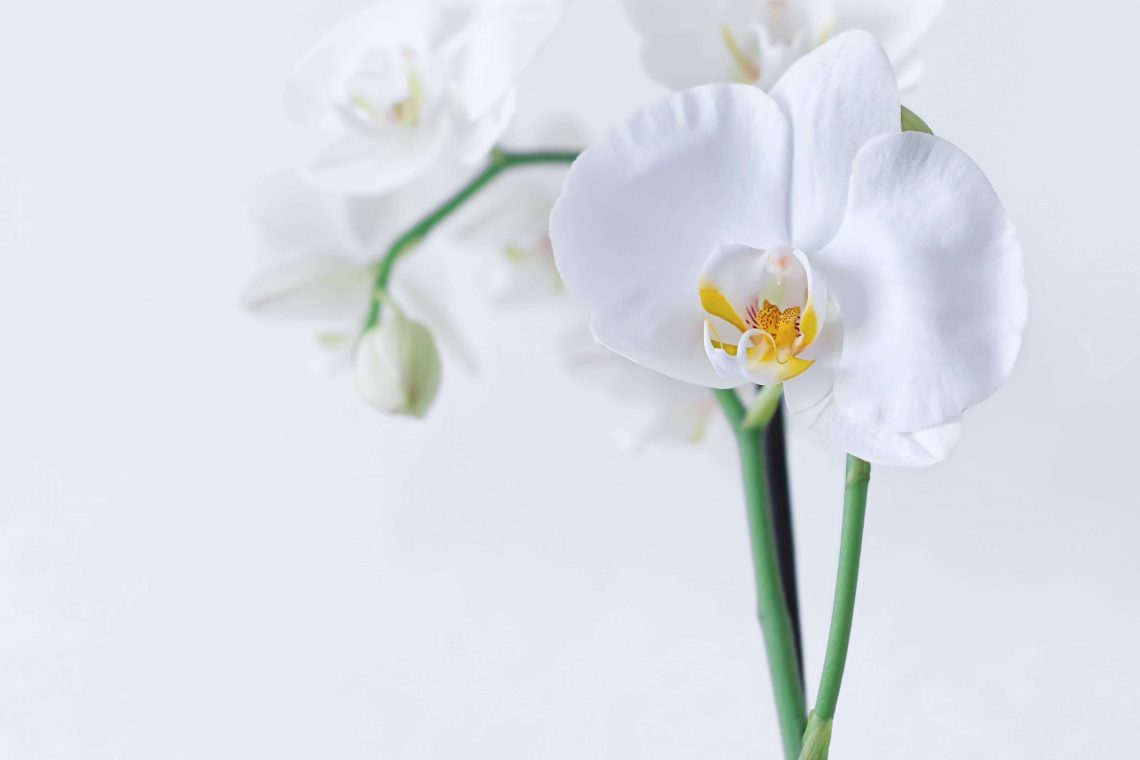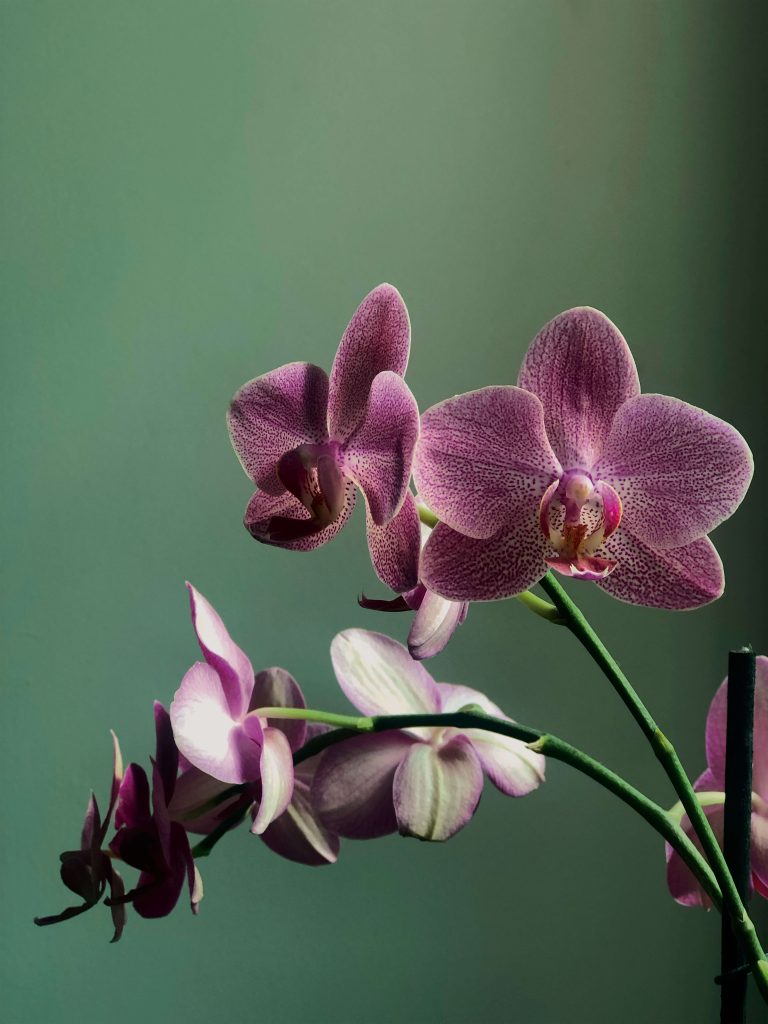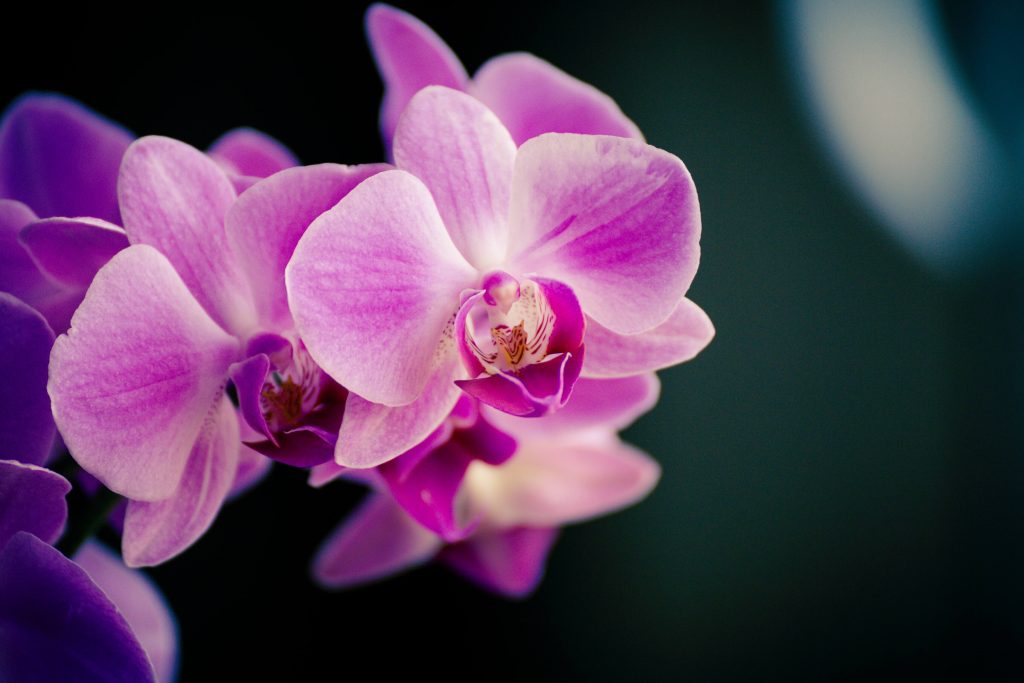
How to Care for Phalaenopsis Orchids at Home
Orchid Phalaenopsis is a charming flower that will not leave any woman indifferent. Recently, it has been very popular among flower-girls in Ukraine. It is a real decoration of the room and the pride of the hostess. If you have in your house appeared this wonderful plant, you need to know that the care of orchids is not easy. It requires some knowledge. There are many secrets for the long life of this plant. We will talk about them today in our blog.
Phalaenopsis grows in the humid tropics under dense tree crowns that hide direct sunlight from it. This flower is very demanding in terms of light, humidity and temperature regime. In the tropics the average daytime temperature is +27 degrees, and at night it’s +17 degrees. Accordingly, the temperature in the room should be +16 – +28 degrees. This is the most comfortable temperature regime for Phalaenopsis.
Adaptation after the store
Finally you have brought the magnificent Phalaenopsis home. The plant is under a lot of stress. It needs time to adapt. For two weeks the flower should be quarantined. Place it separately from other indoor plants. The flower should stand away from direct sunlight. Do not fertilize the plant immediately after purchase. You will harm it. During adaptation, care and watering of the orchid is undesirable. Let it stand alone.
During the period of so-called quarantine, you need to observe the plant. Particular attention should be paid to the new leaves. They can become infested with pests. After a two-week rest, the flower can be accustomed to the sun on the windowsill. The planter should be placed to the sun the same side in which it stood before. You can also start watering. How to do this correctly will be described below.
Purchased Phalaenopsis does not require transplanting. It can grow normally in a store pot for about two years. You need to transplant the flower if it was sold in a pot with sphagnum moss. This is something you should check with the retailer before buying. After transplanting the orchid, there is also no need for care. It is not necessary to treat the leaves with adaptation agents and substances against insects. Leave them dry. The flower needs some time to cope with the stress of a change of pot. Keep a close eye on Phalaenopsis thereafter.
Afterwards, care for the home garden favorite will vary with the blooms and the time of year. In general, Phalaenopsis is considered the most unpretentious variety of orchids. It can withstand large changes in temperature and humidity.

Orchid care during the flowering period
Phalaenopsis sooner or later will please you with beautiful flowers. It may not bloom for three reasons. The first is that the plant is too young. You can determine its age yourself. This is done by simply counting the shoots. An adult green beauty should have 5-8 shoots. The second reason why the plant is in no hurry to enjoy the color is that you are not taking care of it correctly. It is important that Phalaenopsis stand in diffused light. In the shade it will not bloom. The third reason is that the plant needs to be replanted. After that, change the location of the canopy.
In the wild, buds bloom during droughts in the tropics.
When Phalaenopsis finally blooms, you need to follow a few simple rules:
- Water the plant with warm water. It should not be hotter than 35 degrees. A plant with a flower needs extra moisture.
- After showering, remove moisture from the base. Otherwise, Phalaenopsis will begin to rot. Alternatively, the flower can be placed for half an hour in a container of warm water.
- Do not transplant a flowering Phalaenopsis. It will stop blooming. The petals will fall off due to stress.
- Use a fertilizer designed specifically for Phalaenopsis. A flowering beauty needs fertilizer. Fertilizers for other plant species are not suitable and can harm the beloved plant.
- Change the location of the pot and Phalaenopsis will bloom regularly.
How to care for the orchid after flowering
After the petals have fallen, do not rush to cut the flower stalk. Wait for it to wither. There can still be buds on it. When the stalk dries out it will turn black. Now you can cut it off without worrying about leaving behind any hidden buds. The stem is cut off at the base. If there are hidden buds at the bottom, the flower stalk is cut off 1-1.5 cm above the closest one, as shown in the photo.
Once the flower stalk has been cut off, nutrition should be reduced. The plant no longer needs additional nutrients. The amount of watering is also reduced. Now for Phalaenopsis it is necessary to arrange a shower once a month. In addition, several times a month to spray the flower with water from a sprayer.
After a while a new flower stalk should appear. If it does not appear for a long time, and in addition the leaves started to turn yellow, it means that the plant requires a change of location. In a successful location Phalaenopsis will bloom regularly.
How to care for a house orchid in winter
Phalaenopsis have a reduced life rhythm during the cold season. The roots are less able to absorb moisture. It is extremely important to monitor their condition. If the moisture level is sufficient, the roots will be light green or lilac. If the color of the roots has changed to gray, the plant should be watered. Feeding is done less often than in summer.
If the apartment is on the north side, you need to arrange additional lighting. To do this, you need to buy a special fluorescent lamp. If you can not find one, the ordinary light bulb of 60 watts will do. The light source is placed at a distance of 30 cm from the flower.
Phalaenopsis care in the cold season
- The plant needs a temperature change of 5-7 degrees. If there is no strong wind and frost, you can open a window to air it out.
- You should not transplant the flower in the cold season. This is allowed only if absolutely necessary, for example, if the flower is sick.
- It is worth noting that the care of Phalaenopsis, which does not hibernate, is not much different from the summer. It should be watered when the soil is dry. In winter, it is not necessary to additionally spray the leaves with water.
How to maintain the condition of the plant in summer
First of all, if the pot faces south or southwest, move it. Direct sunlight can cause burns on the leaves. But don’t put the Phalaenopsis in the shade. Place it some distance away from the window. Preferably, it should be draped with tulle, which scatters the light. During the warm season, you need to pay attention to three factors:
- Temperature. As mentioned above, for a tropical beauty the comfortable temperature is from 16 to 28 degrees. In Ukraine, the thermometer column can reach a mark of +35. If such heat is short-lived, the plant will tolerate it normally. Prolonged heat can weaken the immunity of Phalaenopsis and even cause diseases. To prevent this from happening, ventilate the room at night and turn on the air conditioner. If you use the latter, place the pot away from the air flow. It also has a negative effect on Phalaenopsis.
Caring for an orchid at home in the summer - Root moisture. In nature, our beauty grows on tree trunks and rocks. This is of great importance when caring for an orchid at home. Watering the soil in the pot makes no sense. You need to approximate the process to that of nature. Arrange Phalaenopsis some semblance of a shower. For several minutes, pour a thin stream of warm water into the pot. Leave the pot for 10 minutes to let the excess water drain off. Wipe off the water at the base to prevent the flower from rotting. The water temperature should be about 35 degrees. You can also immerse the pot for half an hour in a container of warm water. If the water is hard, it should be boiled.
Care and watering of the orchid in the warm season - Air Humidity. In summer, the air is too dry. Phalaenopsis does not tolerate this. To prevent it from getting sick, place a container of water near it.
How to properly care for the orchid in autumn
In summer, Phalaenopsis falls into a state of dormancy. This is due to high temperatures and intense sunlight. With the onset of fall, this period may end and the plant will bloom. If you removed the pot from the south or southwest side for the summer, you can safely return it. The autumn sun is no longer able to burn your beauty. The location on the south side will be ideal for Phalaenopsis, which has released a flower stalk. In November it will not get enough light for a full bloom. A tropical beauty needs at least 12 hours of light per day. Therefore, you need to illuminate the missing hours until the Phalaenopsis blooms.

Caring for the orchid in autumn
If the plant does not get enough light, the inflorescence may wither, only a couple of flowers will bloom, the petals will fall off right after the flower has bloomed.
Phalaenopsis can be transplanted in the fall, if you have not done it in the spring. Fertilize according to the standard scheme – apply fertilizer every second watering.
In the fall, with the heating turned on, the air dries out. Phalaenopsis normally tolerates dry air of 30%.
Where to put the orchid
Phalaenopsis should get enough light. Otherwise, it will use up its vital resources and deteriorate. The beauty from the tropics can be put on a windowsill both on the southern and northern side. The first spring rays of the sun can burn the flower. You will notice pigmentation and burn marks on the leaves. To avoid them, during the warm season the window should be draped with a curtain or blinds.
Where to put an orchid in summer to avoid burns
If you live in a private house or in the warm season you often go to the cottage, Phalaenopsis can be taken out into the yard and placed under a tree. The plant can be placed outside until late fall, until the temperature starts to drop to +10 degrees. Apartment dwellers can take the flower to the loggia.
Bottom line: Now you know how to take care of an orchid at any time of year. If you have something to add, write comments.
Our team of writers is passionate about creating high-quality content that informs and engages readers. With expertise in a variety of topics, we strive to deliver informative and thought-provoking articles that are both informative and enjoyable to read. Whether it's technology, health, lifestyle, or business, our team of writers brings a unique perspective and voice to every piece.






